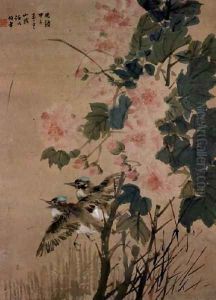Yi (Ren Bonian) Ren Paintings
Yi Ren, better known as Ren Bonian and also known by his courtesy name Ren Yi, was a prominent Chinese painter during the late Qing Dynasty. Born in 1840 in Zhejiang Province, his artistic talent emerged early on, and he would come to be recognized as one of the great masters of the Shanghai School of painting, a style that blended traditional Chinese techniques with Western influences.
Ren Bonian's early life was marked by hardship. His family was poor, which limited his access to formal education and traditional scholarly training. Despite these challenges, he was determined to pursue his passion for art. He initially learned by copying the works of ancient masters, and his skill quickly developed. At the age of 21, Ren moved to Shanghai, which was then a burgeoning center for trade and culture. This move was pivotal for his career, as it exposed him to a wide range of artistic styles and techniques, including those from the West.
In Shanghai, Ren Bonian's reputation as an artist grew. He was especially known for his figure paintings, which often depicted people from various walks of life with a bold and vivid style. His work was not only appreciated for its aesthetic quality but also for its social commentary, as he often painted the marginalized and downtrodden. Ren was also skilled in other traditional subjects, such as birds and flowers, executing them with a fresh and lively approach that set him apart from his contemporaries.
Ren Bonian's style was characterized by a combination of strong brushwork and bright, clear colors, which were somewhat atypical for Chinese painting of the time. He is credited with revitalizing the Chinese painting scene by incorporating the expressive possibilities seen in Western art, while still maintaining a strong connection to Chinese traditions. He was a prolific artist, and his work had a significant impact on the development of modern Chinese painting.
Ren Bonian's legacy is multifaceted. He influenced a generation of artists, and his paintings are widely studied and admired for their unique blend of East and West, and for their humanistic qualities. He passed away in 1895, but his art remains influential and continues to be celebrated in collections and museums around the world.
